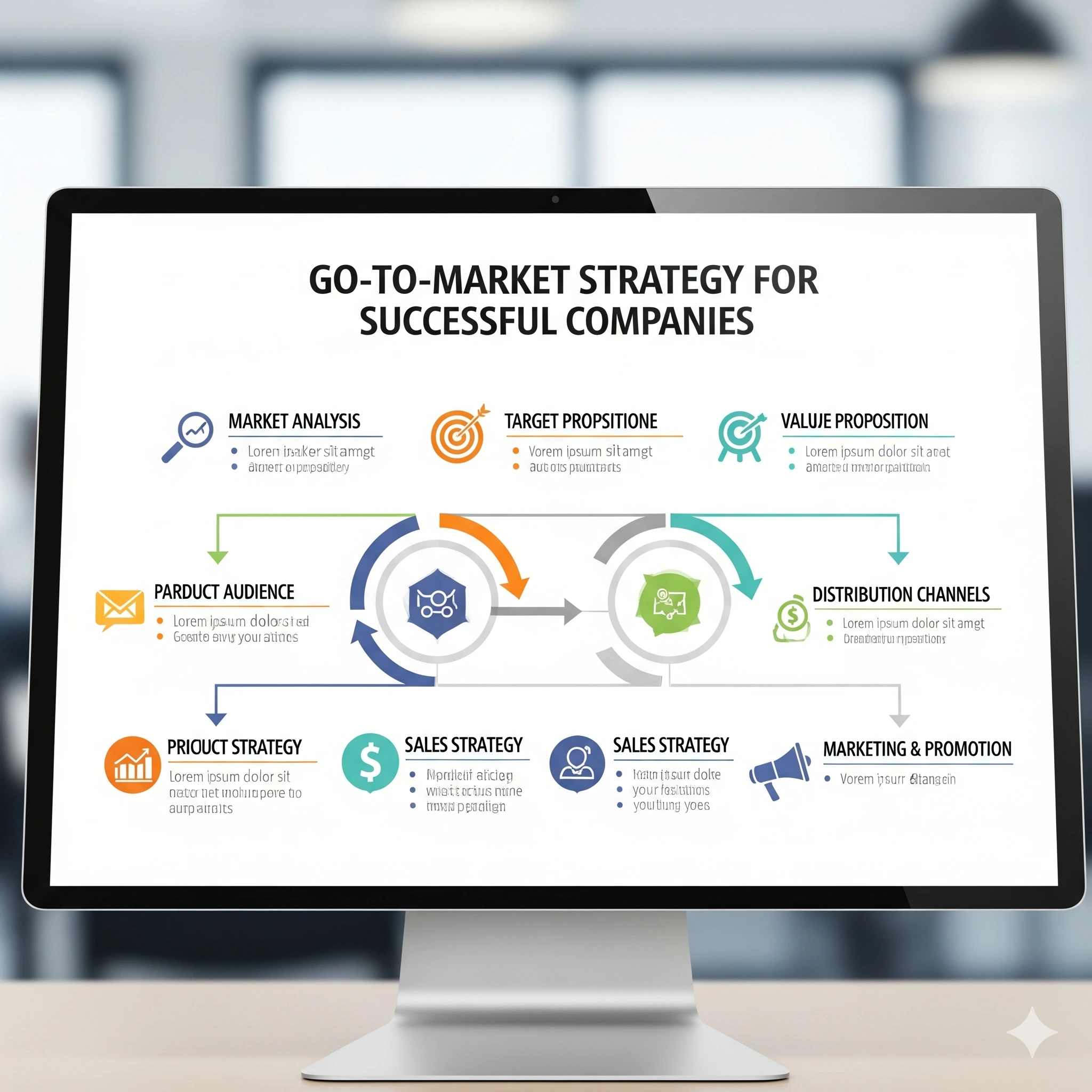
Go-to-Market Strategy for Enterprises That Actually Work
Summary:
A go-to-market strategy is essential for enterprises looking to launch new products, enter new markets, or scale their business efficiently. It provides a clear roadmap for targeting the right audience, positioning products effectively, and aligning sales and marketing teams to drive measurable growth. By following a structured GTM framework, enterprises can reduce risks, accelerate adoption, and improve overall revenue performance.
Modern enterprises also benefit from leveraging technology and data to execute their GTM plans. Automation tools, analytics, and AI-driven sales platforms like PowerDialer.ai help scale personalized outreach, optimize campaigns, and track ROI in real time. Implementing these tactics ensures faster market penetration, higher sales efficiency, and sustainable enterprise growth.

All business growth for successful companies begins with one basic building block: a go-to-market strategy. Without it, even the best product or service concepts will never make it out of the starting gate.
For enterprises, a GTM strategy isn’t just a “nice to have.” It’s a structured plan that guides product launch strategy, market entry strategy, customer acquisition strategy, and long-term scaling. Whether you’re launching a new product, entering new markets, or executing an enterprise growth plan, having a go-to-market framework ensures you’re not leaving success up to chance.
In this article, we’ll break down what a GTM strategy really means, why it’s essential for enterprises, and most importantly, the tactics that actually work in execution.
What is a Go-to-Market (GTM) Strategy?

A go-to-market (GTM) strategy is a structured plan of how a business will take its product or service to the appropriate set of customers and be successful in the market. It sets the target customers, sets the value proposition, and defines the sales, marketing, and distribution strategy. A minimum marketing plan differs from a GTM plan because a GTM plan speaks to the whole process from product positioning to sales enablement and execution. It targets reducing risks, accelerating adoption, and creating a repeatable path to growth. For companies, a healthy GTM strategy offers alignment among teams and delivers measurable results in customer acquisition and revenue.
Definition and Core Purpose
A go-to-market strategy is the playbook companies employ to get products or services in front of customers so they'll adopt, spend, and trade market share for. While marketing plans are concerned mainly with only promotions and awareness, GTM strategies are concerned with everything:
- Who you're selling to (buyer personas)
- How you're different (competitive positioning)
- What channels do you go through
- How alignment between sales and marketing drives execution
Its core purpose is simple: reduce the risks of failure and ensure successful, repeatable product adoption.
Key Components of a GTM Strategy
1. Target Market & Buyer Personas
A GTM strategy begins with understanding who you’re selling to. Defining buyer personas helps enterprises tailor their sales enablement and outreach to decision-makers and influencers in the buying process.
2. Value Proposition
Businesses must clearly state the exact reasons why their solution is important. Translating features into quantifiable advantages from the customer pain areas is what that is.
3. Distribution Channels
The distribution channel choice ensures your product or service hits the market effectively. Channels can be partner networks, direct sales teams, digital platforms, or multi-channel sales models.
4. Pricing & Positioning
Competitive positioning and price are front of mind. You require value-reflected price levels, differentiated from competition, and consistent with your market entry strategy.
5. Sales & Marketing Alignment
Go-to-market success is realized when the sales and marketing firepower are aligned. Alignment prevents conflicting communications, smooth handoffs, and mutual accountability.
Advantages of an Effective GTM Strategy to Businesses
Speedier Market Penetration
With a GTM approach, organizations have managed to expedite product launch planning and gain quicker adoption in new markets.
Enhanced Sales Effectiveness
Accurate buyer personas and sales enablement tools assist sales representatives in qualifying leads, customizing engagement, and closing more effectively.
Less Risk for Product Launch
Rather than speculating, disciplined methodologies exist that minimize errors, and as such, smoother product launches and go-to-market entry strategies ensue.
Long-Term Business Growth
The right go-to-market approach is more than the launch. It's the beginning of an enterprise growth plan that generates repeatable revenue, customer lifetime value, and competitive differentiation.
Enterprise Go-to-Market Framework
Step 1: Define Target Audience and Buyer Personas
All GTM strategies for businesses start with exploration. Who are your best-fit customers? What geographies, industries, and functions do they belong to? Buyer persona mapping ensures that marketing and sales activity is aligned for high-value opportunities.
Step 2: Positioning and Value Proposition
Your competitive positioning decides the way the market sees you. A good value proposition clearly communicates:
- What you solve
- Why are you better than others
- How does your solution map to company growth plans
Step 3: Select the Appropriate Sales & Distribution Channels
Not every business needs every channel. For instance, B2B go-to-market is most often direct sales teams with digital demand generation fill-ins. Appropriate distribution channels create maximum reach and cost savings
Step 4: Unite Sales and Marketing Teams
Marketing and sales alignment is where it's headed. Without goal-aligned organizations, they are literally spending money and time. These two teams need to get aligned on buyer personas, lead scoring, messaging, and metrics.
Step 5: Execute with Technology
GTM execution in such periods relies on technology. Automation software, AI dialers, analytics platforms, and customer interaction solutions increase efficiency, facilitate personalization, and equip businesses with the know-how they need to expand.
Ready to let technology fuel your GTM performance? Book a demo today with PowerDialer.ai and learn how AI enables sales productivity.
Typical Challenges Companies Face in GTM Implementation
Sales and Marketing Alignment
Most of the biggest issues firms experience with go-to-market execution are rooted in sales and marketing org misalignment. Without alignment, leads are lost, and messaging is broken. Marketing produces leads that sales would not classify as high quality, and frustration abounds. Misalignment squanders dollars and falls behind customer acquisition and total top-line growth. Effective GTM requires co-sharing KPIs, joint planning, and visibility among both teams.
How to Improve Alignment:
- Establish co-shared KPIs that both marketing and sales are accountable for.
- Schedule frequent joint meetings to review lead quality and campaign performance.
- Implement lead scoring systems that allow marketing to pass on only qualified leads to sales.
- Get messages across all channels aligned for one customer experience.
- Foster collaboration through co-sharing dashboards and CRM solutions.
Poor Leveraging of Data
Data is perhaps one of the most valuable possessions companies have, but it is not being utilized to its fullest potential by the majority. Even poor data quality, missing data, or the absence of advanced analytics tools could lead to chances lost in customer acquisition. Without quality information, businesses are not able to see patterns, predict customer behavior, or identify high-priority leads. That means time-consuming sales efforts and inefficient marketing campaigns. It is therefore imperative to utilize clean, current data in order to inform more enlightened decisions and maximize go-to-market effectiveness.
How to Make Data Work:
- Have a single, clean, fresh customer and lead database.
- Utilize analytics to track buyer behavior and identify trends.
- Segment customers demographically, by business, or by buying behavior.
- Sync CRM and marketing automation platforms for smooth data flow.
- Track metrics regularly to improve targeting and outreach processes.
Scaling Personalized Outreach
Personalization is the way to win enterprise sales nowadays, but it is difficult to scale it to thousands of potential purchasers. It is challenging for enterprises to be authentic to themselves while attempting to reach many simultaneously in an effective way. Generic messaging lowers engagement, and hyper-personalized efforts are prohibitively expensive without the right tools. Scaling without losing authenticity is important to establish trust and boost conversion rates.
Scaling Personalization:
- Create deep buyer personas that drive messaging at scale.
- Personalize email, phone, and follow-up with AI-powered tools.
- Prioritize leads into levels and reach out according to personalization.
- Adjust significant elements of the message with relevance using templates.
- Monitor engagement metrics to iteratively improve personalization techniques.
Measuring Success and ROI
Another issue is an inability to properly measure success and go-to-market ROI. The majority of companies fail to set easy-to-understand KPIs or leverage metrics that fail to comment on business results. Without structure, nobody can tell which campaigns, channels, or sales tactics are effective. Lack of visibility sabotages the optimization process and blows the budget.
How to Measure and Improve ROI:
- Establish measurable, defined KPIs for each stage of the GTM strategy.
- Track leading (engagement, qualified leads) and lagging (revenue, conversions) indicators.
- Use dashboards and analytics platforms to get real-time feedback.
- Constantly audit gaps and refine campaigns.
- Hold people accountable by framing marketing and sales activities aligned with revenue impact.
Winning Enterprise Strategies
Scaling Personalization
Through automation and AI functionalities, companies can personalize calls, emails, and messages without losing out on efficiency. This is an enhancement in customer acquisition methods.
Sales Enablement
Arming sales teams with predictive dialers, content libraries, and CRM integration increases productivity for sales teams and accelerates go-to-market deployment.
Data-Driven Decisions
Data-driven ones perform better than non-data-driven ones. Data gives insights into buyer behavior, campaign activity, and revenue forecast.
Building Flexible GTM Teams
Markets shift fast. Businesses require flexible teams to accommodate new channels, competitive realities, and customer needs.
Conclusion
A go-to-market strategy is the foundation for a successful business product launch instead of an expensive failure. With the right mix of disciplined frameworks, aligned teams, and data-driven operations, companies unleash momentum in rapid market growth, enhanced sales productivity, and long-term growth.
Analysis of data plus speed of execution equals business growth. The moment to invest in your GTM strategy is now.
Ready to activate your go-to-market strategy. Discover how PowerDialer.ai accelerates outreach, increases efficiency, and drives growth. Get a demo today.
FAQs
Q1. What is the purpose of a go-to-market strategy?
A GTM strategy provides a strategic outline of how an enterprise brings a product/service to market, attracts customers, and generates revenue.
Q2. What is the difference between GTM and marketing strategy?
A GTM is more focused; it targets sales, distribution, and delivery, whereas a marketing strategy leans more towards awareness and promotion.
Q3. Why do businesses need a GTM framework?
It minimizes risks, accelerates adoption, and provides steady revenue growth.
Q4. What are the main elements of a GTM strategy?
Target market, positioning, value proposition, sales/marketing alignment, and quantifiable KPIs.
Q5. How does technology amplify GTM execution?
By automating sales interactions, facilitating personalization, offering analytics, and optimizing sales productivity.
